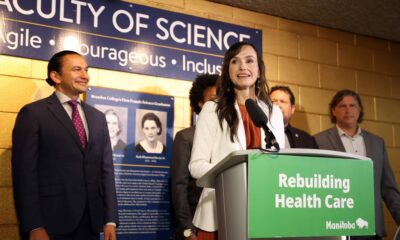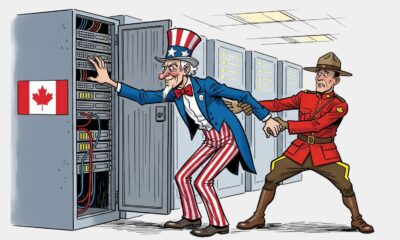Science
Exploring the Complex Nature of Space-Time in Modern Physics

The concept of space-time, a central element of Albert Einstein‘s theory of relativity, has profoundly reshaped our understanding of the universe. It presents a complex interplay between space and time, often described as the “fabric of reality.” As scientists and philosophers grapple with what it means for space-time to exist, the implications extend beyond theoretical physics to fundamental questions about the nature of existence itself.
Understanding Space-Time
Space-time can be viewed in two primary ways: as a fixed, four-dimensional “block universe” that includes all events—past, present, and future—or as a dynamic structure that bends and curves in response to gravitational forces. This dual perspective raises significant questions about the essence of space-time. Is it a concrete structure, a substance, or merely a metaphor?
The philosophical implications of these questions are far-reaching. They influence our interpretations of modern physics and shape diverse concepts such as time travel, multiverses, and the origins of the universe. These discussions also highlight the inconsistencies in the language used to describe space-time, often leading to confusion.
Philosopher Ludwig Wittgenstein warned that philosophical problems arise when “language goes on holiday.” In this context, familiar terms like “time” and “exist” have been redefined within specific scientific frameworks, creating a disconnect between everyday language and technical terminology.
Eternalism and the Nature of Existence
Within the philosophy of physics, the concept of eternalism posits that all events in time are equally real. This perspective asserts that time does not flow; rather, every moment exists simultaneously in a four-dimensional structure. Here, the term “timeless” is taken literally, suggesting that the entirety of the universe’s history is laid out within space-time without change.
This leads to a fundamental dilemma: if all events are real and already exist, what does it mean for space-time to exist? The distinction between existence and occurrence becomes crucial. For example, consider an elephant in the room. You would say, “This elephant exists,” indicating a three-dimensional object with a persistent reality. In contrast, a fleeting, ghostly image of an elephant that appears momentarily does not exist in the same way; it merely occurs.
Applying this analogy to space-time raises profound questions. Does space-time endure as the elephant does? Does it have “now” moments or is it simply a framework for organizing events? Eternalism complicates this distinction, suggesting that if time is an illusion, then understanding space-time as a fixed structure becomes problematic.
Moreover, if we accept that space-time exists in a timeless sense, we must ask when this block exists. Does it exist without unfolding or changing? If so, this introduces another layer of complexity, possibly necessitating a five-dimensional framework to accommodate our understanding of existence.
The confusion surrounding space-time also permeates popular culture and science fiction. Films like The Terminator illustrate a fixed timeline where time travel is possible, yet the timeline remains unchanged. In contrast, Avengers: Endgame presents a narrative where characters can alter past events, implying a more dynamic understanding of time and space.
Physicists often find themselves navigating these complex interpretations of space-time. The mathematical framework of general relativity remains intact, but the interpretative challenges continue to grow. The way we discuss space-time influences not only our understanding of reality but also our efforts to reconcile general relativity with quantum theory.
The ongoing debate regarding the nature of space-time is not merely an academic exercise; it shapes our comprehension of the universe and our place within it. Clarifying these concepts is vital as we continue to explore the intricate relationship between time, existence, and the cosmos itself.
Daryl Janzen, the author of this exploration, maintains a position within academia but has no affiliations that would influence the content of this article. Understanding space-time is more than a technical inquiry; it reflects our broader quest to define the nature of reality we inhabit.
-

 Education3 months ago
Education3 months agoBrandon University’s Failed $5 Million Project Sparks Oversight Review
-

 Science4 months ago
Science4 months agoMicrosoft Confirms U.S. Law Overrules Canadian Data Sovereignty
-

 Lifestyle3 months ago
Lifestyle3 months agoWinnipeg Celebrates Culinary Creativity During Le Burger Week 2025
-

 Health4 months ago
Health4 months agoMontreal’s Groupe Marcelle Leads Canadian Cosmetic Industry Growth
-

 Science4 months ago
Science4 months agoTech Innovator Amandipp Singh Transforms Hiring for Disabled
-

 Technology4 months ago
Technology4 months agoDragon Ball: Sparking! Zero Launching on Switch and Switch 2 This November
-

 Education4 months ago
Education4 months agoRed River College Launches New Programs to Address Industry Needs
-

 Technology4 months ago
Technology4 months agoGoogle Pixel 10 Pro Fold Specs Unveiled Ahead of Launch
-

 Business3 months ago
Business3 months agoRocket Lab Reports Strong Q2 2025 Revenue Growth and Future Plans
-

 Technology2 months ago
Technology2 months agoDiscord Faces Serious Security Breach Affecting Millions
-

 Education4 months ago
Education4 months agoAlberta Teachers’ Strike: Potential Impacts on Students and Families
-

 Education4 months ago
Education4 months agoNew SĆIȺNEW̱ SṮEȽIṮḴEȽ Elementary Opens in Langford for 2025/2026 Year
-

 Science4 months ago
Science4 months agoChina’s Wukong Spacesuit Sets New Standard for AI in Space
-

 Business4 months ago
Business4 months agoBNA Brewing to Open New Bowling Alley in Downtown Penticton
-

 Business4 months ago
Business4 months agoNew Estimates Reveal ChatGPT-5 Energy Use Could Soar
-

 Technology4 months ago
Technology4 months agoWorld of Warcraft Players Buzz Over 19-Quest Bee Challenge
-

 Business4 months ago
Business4 months agoDawson City Residents Rally Around Buy Canadian Movement
-

 Technology2 months ago
Technology2 months agoHuawei MatePad 12X Redefines Tablet Experience for Professionals
-

 Technology4 months ago
Technology4 months agoFuture Entertainment Launches DDoD with Gameplay Trailer Showcase
-

 Top Stories3 months ago
Top Stories3 months agoBlue Jays Shift José Berríos to Bullpen Ahead of Playoffs
-

 Technology4 months ago
Technology4 months agoGlobal Launch of Ragnarok M: Classic Set for September 3, 2025
-

 Technology4 months ago
Technology4 months agoInnovative 140W GaN Travel Adapter Combines Power and Convenience
-

 Science4 months ago
Science4 months agoXi Labs Innovates with New AI Operating System Set for 2025 Launch
-

 Technology4 months ago
Technology4 months agoNew IDR01 Smart Ring Offers Advanced Sports Tracking for $169










